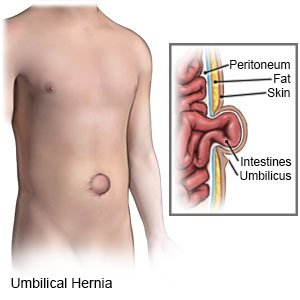Umbilical Hernia in Children
Medically reviewed by Drugs.com. Last updated on Aug 4, 2025.
An umbilical hernia is a bulge through the abdominal wall near your child's umbilicus (belly button). The hernia may contain tissue from the abdomen, part of an organ (such as the intestine), or fluid.
 |
WHILE YOU ARE HERE:
Informed consent
is a legal document that explains the tests, treatments, or procedures that your child may need. Informed consent means you understand what will be done and can make decisions about what you want. You give your permission when you sign the consent form. You can have someone sign this form for you if you are not able to sign it. You have the right to understand your child's medical care in words you know. Before you sign the consent form, understand the risks and benefits of what will be done to your child. Make sure all of your questions are answered.
Stay with your child for comfort and support
as often as possible while he or she is in the hospital. Ask another family member or someone close to the family to stay with your child when you cannot be there. Bring items from home that will comfort your child, such as a favorite blanket or toy.
An IV
is a small tube placed in your child's vein that is used to give medicine or liquids.
Medicines:
- Medicines may be given to decrease pain and swelling. Do not wait until the pain is severe before you ask for your child's medicine.
- Sedative medicine may be given to help your child relax. This medicine may be needed before your child's healthcare provider manually reduces the hernia.
- Antibiotics help prevent a bacterial infection. Your child may be given antibiotics before surgery.
Tests:
- Blood tests may show infection, kidney function, and give information about your child's overall health.
- Ultrasound, CT, or MRI may show the tissue or organ that is contained within the hernia. It may also show if there is a lack of blood flow to the organs, a blockage in the intestines, or a hole in the intestines. Your child may be given contrast liquid to help the organs show up better in the pictures. Tell the healthcare provider if your child has ever had an allergic reaction to contrast liquid. Do not let your child enter the MRI room with anything metal. Metal can cause serious injury. Tell the healthcare provider if your child has any metal in or on his or her body.
Treatment:
- A nasogastric (NG) tube may be inserted to relieve nausea and vomiting. An NG tube is a thin tube that is inserted through your child's nose and into his or her stomach. The tube can remove fluid and air from your child's stomach.
- Manual reduction may be needed. Manual reduction means your child's healthcare provider will use his or her hands to put firm, steady pressure on your child's hernia. Pressure is applied until the hernia disappears inside the abdominal wall. This procedure may help reduce the hernia while your child waits to have surgery.
- Surgery is done if your child's hernia does not go away on its own by age 4 to 5 years old or causes complications. Your child may need surgery right away if the hernia stops blood flow to any of his or her organs. Your child may also need surgery right away if a hole forms in the intestines or they get trapped inside the hernia.
RISKS:
An umbilical hernia may cause a blockage or hole in your child's intestines. It may also stop blood flow to his or her intestines. This may become life-threatening.
CARE AGREEMENT:
You have the right to help plan your child's care. Learn about your child's health condition and how it may be treated. Discuss treatment options with your child's healthcare providers to decide what care you want for your child.© Copyright Merative 2025 Information is for End User's use only and may not be sold, redistributed or otherwise used for commercial purposes.
The above information is an educational aid only. It is not intended as medical advice for individual conditions or treatments. Talk to your doctor, nurse or pharmacist before following any medical regimen to see if it is safe and effective for you.
Learn more about Umbilical Hernia
Treatment options
Care guides
Symptoms and treatments
Further information
Always consult your healthcare provider to ensure the information displayed on this page applies to your personal circumstances.
